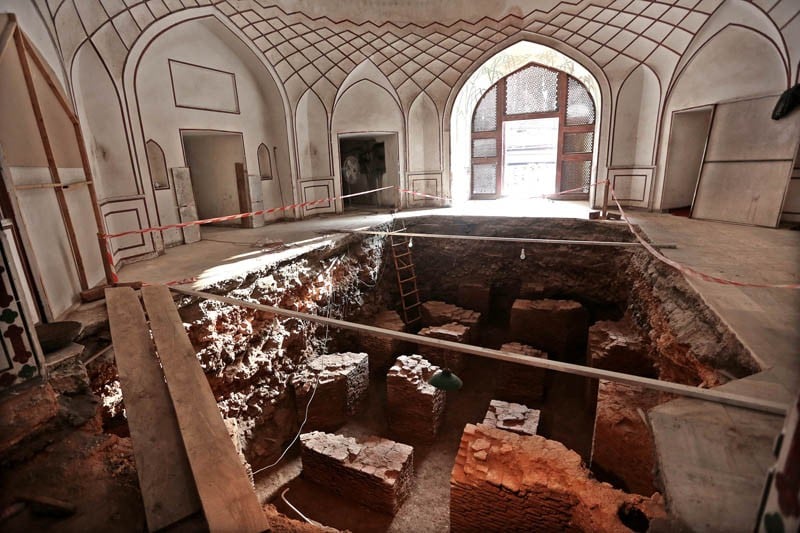

Delhi Gate in Lahore is engulfed by machinery, construction workers and cement tills these days as the walled city is being preserved by the Walled City of Lahore Authority (WCLA).
Just pass through the Delhi gate, with its monumental arch and muddy puddles, and turn left. There is a black metallic gate that leads to the Delhi Gate School but you turn right instead. And, there it is -- the back entrance to the majestic Wazir Khan Hamam.
The interior of the Hamam has been excavated by the WCLA funded by the Agha Khan Trust for Culture. Red strings and small wooden poles mark the area -- probably to beware people from falling over.
The Hamam was built by Wazir Khan during the times of Mughal Emperor Shah Jehan by the Governer of Lahore, Sheikh Ilmuddin Ansari, in 1634. It was meant for Jehangir’s consort. The Shahi Hamam, as it is commonly referred to, was probably used by royal travellers to bath and freshen up before walking to the Wazir Khan mosque for their prayers.
Built during the days of Shah Jehan, the Hamam was retouched by the British and, much later, by the Nawaz Sharif government in 1991. Due to a lack of funds, the government simply laid out concrete and marble flooring to cover what was left of pools, fountains and their heating system.
The team is now searching the original flooring and has managed to excavate a pool, a heating system, an old floor and something that seems to be a staircase. Several ceramic and clay artefacts have also been discovered. These are being packed, labelled and numbered now.
The heating system has never been discovered in this region before, with small pillar-like brick structures, with an entrance that opens into a pool. The unique system has been discovered for the first time. The old entrance is now being being sealed by a wall at a distance of a few feet, to prevent the public from damaging it any further.
Hamams were introduced in the sub-continent by the Mughals. The Shahi Hamam is one of the rare examples of this building type which is still prevalent today. The building is a magnificent example of the Shahjahani architecture, a mixture of Persian and Turkish design -- the only one of its kind remaining in Lahore. The Hamam had 21 rooms, 8 marble pools for hot baths and another 8 for cold ones. Five rooms were reserved for steam baths. The roofs and walls were embellished with stunning floral paintings and roshandaans in the roof as the halls and rooms are completely enclosed to maintain privacy. This was the sole source of light in the Hamam and gave it a unique hue during daytime. Special rooms were built for luxurious massages and beauty therapy. There were similar sections for women, managed by female staff.
The heating system (probably wood logs used to heat the water and convert it to steam which then passed through the pillars) was destroyed during the Sikh rule and not renovated by the British. Instead the building was converted to a living quarter. This eventually ruined the Hamam.
The Hamam’s exterior was encroached on and seepage destroyed the walls and the fresco work on it. The floor was repaired many times and the original floor and fountains buried under it. Thus the project is attempting to undo hundreds of years of neglect and damage.
The WCLA has removed encroachers and plans to repair some of the decayed parts of the Hamam and dig out the real old floors.
"The project is unique," said Maryam Rabi, an architect from BNU, who is also a part of the project. "It is the first one done with proper equipment. We hope to finish this documentation and exploration by next year or else we might need an extension. After this we can plan how to conserve the site and whether to turn it into a museum."